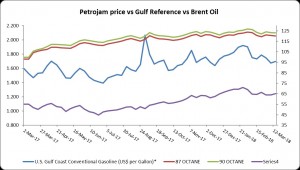Brent Oil
Brent oil prices increased by 1.93% or US$1.23, as prices rose this week. Oil traded on March 15, 2018 at a price of $65.12 per barrel relative to US$63.89 last week. Brent oil began the year at US$68.07 per barrel.
Petrojam prices
87 Octane prices decrease week over week, by 0.22% (JMD$0.27). Additionally 90 Octane fell by 0.22% or (JMD$0.27) week over week. 87 Octane and 90 Octane opened the year at J$121.04 and J$123.88 respectively and now trades at J$120.24 and J$123.08 per litre respectively.

Figure 1: Petrojam, U.S. Gulf Coast Conventional Gasoline Regular and Brent Crude Oil 1 Year Price History
This Week in Petroleum
The production of US crude oil increased 5% in the last year, amounting to 10 million barrels per day in the last two months of the year. U.S. crude oil production grew on average by 463,000 barrels per day (b/d) in 2017 to 9.3 million b/d annually after declining by 551,000 b/d in 2016. US crude oil reached its highest of 1.2 million b/d year-over-year November 2017 in U.S. history, surpassing 10 million b/d, a level last reached in 1970. There has been significant growth in the crude oil industry for the last decade, primarily deiven by the production from tight rock formations using horizontal drilling and hydraulic fracturing. “ It is projected by the EIA that U.S. crude oil production will continue growing in 2018 and 2019, averaging 10.7 million b/d and 11.3 million b/d, respectively.”
“Texas continues to be the largest crude oil-producing state in 2017, averaging 3.5 million b/d. Texas also grew annual production more than all other states and the Federal Offshore Gulf of Mexico (GOM) in 2017, growing by 298,000 b/d. Significant growth occurred in several productive plays within the Permian region in Texas. Growth in the Permian also drove New Mexico to the second-largest growth rate in 2017 with a 74,000 b/d increase.”
“New Mexico has become the the third-largest crude oil-producing state in the second half of 2017 ahead of California and Alaska despite the fact that it produced less on an annual average basis. The new projects and expansions which commenced two years ago in Gulf of Mexico hiked the production in 2017, along with two other projects that began in 2017 contributed to 51,000 b/d of annual growth. Production levels in Colorado, Oklahoma, and North Dakota each grew by more than 30,000 b/d from 2016 to 2017, while Alaskan production increased only slightly. California’s production declined 34,000 b/d, the state’s third consecutive annual decline.”
For additional information, click on link below.
Disclaimer:
Analyst Certification -The views expressed in this research report accurately reflect the personal views of Mayberry Investments Limited Research Department about those issuer (s) or securities as at the date of this report. Each research analyst (s) also certify that no part of their compensation was, is, or will be, directly or indirectly, related to the specific recommendation (s) or view (s) expressed by that research analyst in this research report.
Company Disclosure -The information contained herein has been obtained from sources believed to be reliable, however its accuracy and completeness cannot be guaranteed. You are hereby notified that any disclosure, copying, distribution or taking any action in reliance on the contents of this information is strictly prohibited and may be unlawful. Mayberry may effect transactions or have positions in securities mentioned herein. In addition, employees of Mayberry may have positions and effect transactions in the securities mentioned herein.
